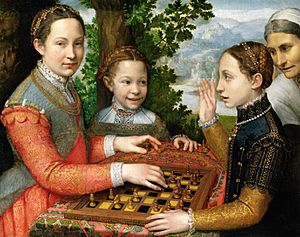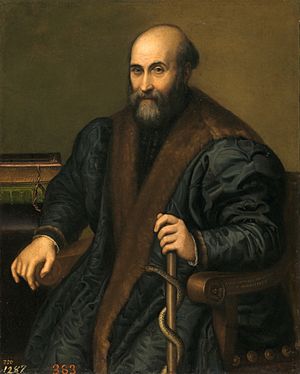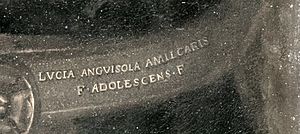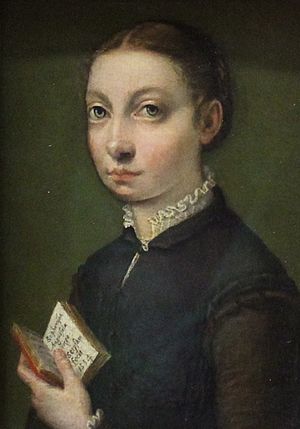Lucia Anguissola facts for kids
Quick facts for kids
Lucia Anguissola
|
|
|---|---|
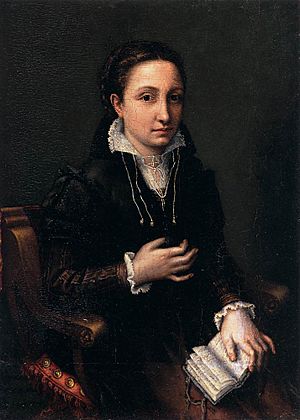
Lucia Anguissola, Self-Portrait, 1557, Castello Sforzesco, Milan
|
|
| Born |
Lucia Anguissola
1536 or 1538 Cremona, Italy
|
| Died | c. 1565, before 1568 |
| Nationality | Italian |
| Known for | Painting |
| Movement | Italian Mannerism |
Lucia Anguissola (born around 1536 or 1538 – died about 1565–1568) was a talented Italian painter. She lived during the late Renaissance period. This was a time when art, science, and culture were reborn in Europe. Lucia was known for her unique painting style called Mannerism. This style often showed figures in unusual poses and bright colors.
Lucia was born in Cremona, Italy. She was the third of seven children born to Amilcare Anguissola and Bianca Ponzoni. Her father was from a noble family in Genoa. He wanted all his five daughters to learn art. They also received a humanist education, which focused on human values and achievements.
Lucia likely learned to paint from her older sister, Sofonisba Anguissola. Sofonisba was a very famous artist. Lucia's paintings, mostly portraits of people, looked a lot like her sister's work. People who saw her art back then thought she was incredibly skilled. One writer from the 1600s, Filippo Baldinucci, even said Lucia could have become better than Sofonisba if she hadn't died so young.
One of her paintings, Portrait of Pietro Manna, was highly praised. A famous artist named Giorgio Vasari saw it after Lucia had passed away. He wrote that Lucia left behind a great reputation through her beautiful paintings.
Lucia Anguissola is shown in a painting by her sister Sofonisba from 1555. It's called The Chess Game. In this painting, Lucia is on the far left, with her hands on the chessboard. Her younger sisters, Minerva and Europa, are also in the picture. Europa is smiling, and Minerva is raising her hand. A servant stands behind them. This painting shows how the sisters interacted and how important their family was. Lucia looks directly at you, inviting you to join their game.
Lucia's Famous Paintings
Portrait of Pietro Manna
Lucia painted the Portrait of Pietro Manna between 1557 and 1560. This painting shows how much Lucia knew about humanism, classical mythology, and art. It's also the only painting she signed with her full name. Her signature says "Lucia Anguissola Amilcaris F[ilia] Adolescens F[ecit]." This means "Lucia Anguissola, young daughter of Amilcare, made this."
In this painting, Lucia showed off her family's name and history. The man in the portrait is thought to be a relative of the Anguissola family. Many people thought he was a doctor, but that's not correct. The snake on the rod in his left hand has a special meaning. While a rod with a snake can be a medical symbol (Asclepeion rod), here it probably refers to Lucia's family name. "Anguis Sola" means "the lone snake," which was on her family's coat of arms. This painting might have been a way to show that another great female painter was rising in the Anguissola family. Lucia's father, Amilcare, showed this painting to Giorgio Vasari after Lucia died.
Lucia was very skilled at showing the man's personality. She used mostly shades of grey and brown. You can see his unique personality in his expressive face and slightly uneven shoulders.
Self-Portrait
In her Self-Portrait from 1557, Lucia shows herself sitting in simple, elegant clothes. She holds a book in her left hand, which might be a prayer book. Her right hand rests on her heart. This is similar to her sister Sofonisba's own self-portrait from 1554. Both sisters' self-portraits share many similarities, like their clothing and how they look at the viewer. These similarities show their shared upbringing and maturity.
Some art experts believe Lucia's "suspended" and "gloomy" gaze in her self-portrait shows how she felt living in her famous sister's shadow. This feeling might also be seen in other portraits by Lucia and in Sofonisba's painting The Chess Game.
Other Works
Lucia's only other signed painting is a half-length self-portrait from around 1557. She also painted a Virgin and Child. Another painting, A Portrait of a Woman (early 1560s), might be a self-portrait by Lucia or Sofonisba, or a portrait of Lucia by Sofonisba. Two other portraits, possibly of her sister Minerva Anguissola, might also be by Lucia.
See also
 In Spanish: Lucia Anguissola para niños
In Spanish: Lucia Anguissola para niños


